Chair
One of the basic pieces of furniture, a chair is a type of seat. Its primary features are two pieces of a durable material, attached as back and seat to one another at a 90° or slightly greater angle, with usually the four corners of the horizontal seat attached in turn to four legs—or other parts of the seat's underside attached to three legs or to a shaft about which a four-arm turnstile on rollers can turn—strong enough to support the weight of a person who sits on the seat (usually wide and broad enough to hold the lower body from the buttocks almost to the knees) and leans against the vertical back (usually high and wide enough to support the back to the shoulder blades). The legs are typically high enough for the seated person's thighs and knees to form a 90° or lesser angle.[1][2] Used in a number of rooms in homes (e.g. in living rooms, dining rooms, and dens), in schools and offices (with desks), and in various other workplaces, chairs may be made of wood, metal, or synthetic materials, and either the seat alone or the entire chair may be padded or upholstered in various colors and fabrics.
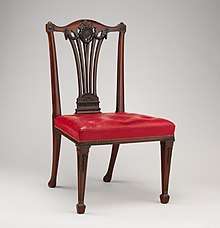
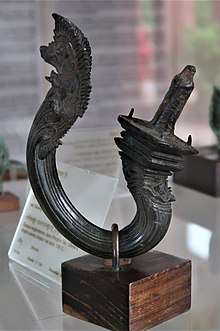
Chairs vary in design. An armchair has armrests fixed to the seat;[3] a recliner is upholstered and under its seat is a mechanism that allows one to lower the chair's back and raise into place a fold-out footrest;[4] a rocking chair has legs fixed to two long curved slats; and a wheelchair has wheels fixed to an axis under the seat.[5]
Etymology
Chair comes from the early 13th-century English word chaere, from Old French chaiere ("chair, seat, throne"), from Latin cathedra ("seat").[6]
History
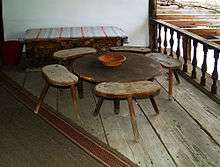
The chair has been used since antiquity, although for many centuries it was a symbolic article of state and dignity rather than an article for ordinary use. "The chair" is still used as the emblem of authority in the House of Commons in the United Kingdom[7] and Canada,[8] and in many other settings. In keeping with this historical connotation of the "chair" as the symbol of authority, committees, boards of directors, and academic departments all have a 'chairman' or 'chair'.[9] Endowed professorships are referred to as chairs.[10] It was not until the 16th century that chairs became common.[11] Until then, people sat on chests, benches, and stools, which were the ordinary seats of everyday life. The number of chairs which have survived from an earlier date is exceedingly limited; most examples are of ecclesiastical, seigneurial or feudal origin.
Chairs were in existence since at least the Early Dynastic Period of Egypt (c. 3100 BC). They were covered with cloth or leather, were made of carved wood, and were much lower than today's chairs – chair seats were sometimes only 10 inches (25 cm) high.[12] In ancient Egypt chairs appear to have been of great richness and splendor. Fashioned of ebony and ivory, or of carved and gilded wood, they were covered with costly materials, magnificent patterns and supported upon representations of the legs of beasts or the figures of captives. Generally speaking, the higher ranked an individual was, the taller and more sumptuous was the chair he sat on and the greater the honor. On state occasions the pharaoh sat on a throne, often with a little footstool in front of it.[13]
The average Egyptian family seldom had chairs, and if they did, it was usually only the master of the household who sat on a chair. Among the better off, the chairs might be painted to look like the ornate inlaid and carved chairs of the rich, but the craftsmanship was usually poor.[12]
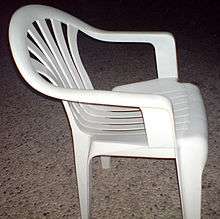
The earliest images of chairs in China are from sixth-century Buddhist murals and stele, but the practice of sitting in chairs at that time was rare. It wasn't until the twelfth century that chairs became widespread in China. Scholars disagree on the reasons for the adoption of the chair. The most common theories are that the chair was an outgrowth of indigenous Chinese furniture, that it evolved from a camp stool imported from Central Asia, that it was introduced to China by Christian missionaries in the seventh century, and that the chair came to China from India as a form of Buddhist monastic furniture. In modern China, unlike Korea or Japan, it is no longer common to sit at floor level.[15]
In Europe, it was owing in great measure to the Renaissance that the chair ceased to be a privilege of state and became a standard item of furniture for anyone who could afford to buy it. Once the idea of privilege faded the chair speedily came into general use. Almost at once the chair began to change every few years to reflect the fashions of the day.[16]
In the 1880s, chairs became more common in American households and usually there was a chair provided for every family member to sit down to dinner. By the 1830s, factory-manufactured “fancy chairs” like those by Sears. Roebuck, and Co. allowed families to purchase machined sets. With the Industrial Revolution, chairs became much more available.[17]
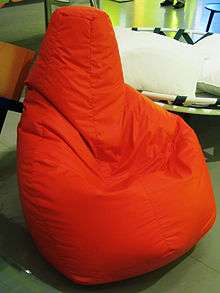
The 20th century saw an increasing use of technology in chair construction with such things as all-metal folding chairs, metal-legged chairs, the Slumber Chair, moulded plastic chairs and ergonomic chairs.[18] The recliner became a popular form, at least in part due to radio and television.
The modern movement of the 1960s produced new forms of chairs: the butterfly chair (originally called the Hardoy chair), bean bags, and the egg-shaped pod chair that turns. It also introduced the first mass-produced plastic chairs such as the Bofinger chair in 1966.[19] Technological advances led to molded plywood and wood laminate chairs, as well as chairs made of leather or polymers. Mechanical technology incorporated into the chair enabled adjustable chairs, especially for office use. Motors embedded in the chair resulted in massage chairs.[20]
Materials
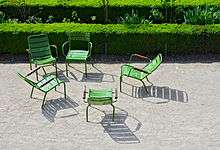
Chairs can be made from wood, metal, or other strong materials, like stone or acrylic. In some cases, multiple materials are used to construct a chair; for example, the legs and frame may be made from metal and the seat and back may be made from plastic. Chairs may have hard surfaces of wood, metal, plastic, or other materials, or some or all of these hard surfaces may be covered with upholstery or padding. The design may be made of porous materials, or be drilled with holes for decoration; a low back or gaps can provide ventilation. The back may extend above the height of the occupant's head, which can optionally contain a headrest. Chairs can also be made from more creative materials, such as recycled materials like cutlery and wooden play bricks, pencils, plumbing tubes, rope, corrugated cardboard, and PVC pipe.[21]
In rare cases, chairs are made out of unusual materials, especially as a form of art or experimentation. Raimonds Cirulis, a Latvian interior designer, created a volcanic hanging chair that is a handmade out of volcanic rock.[22][23] Peter Brenner, a Dutch-born German designer, has created a chair made from lollipop sugar – 60 pounds (27 kg) of confectioners' sugar.[24]
Design and ergonomics
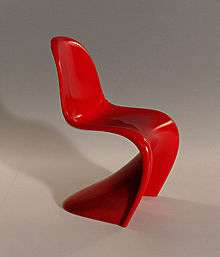
Chair design considers intended usage, ergonomics (how comfortable it is for the occupant),[25] as well as non-ergonomic functional requirements such as size, stacking ability, folding ability, weight, durability, stain resistance, and artistic design. Intended usage determines the desired seating position. "Task chairs", or any chair intended for people to work at a desk or table, including dining chairs, can only recline very slightly; otherwise the occupant is too far away from the desk or table. Dental chairs are necessarily reclined. Easy chairs for watching television or movies are somewhere in between depending on the height of the screen.
Ergonomic design distributes the weight of the occupant to various parts of the body. A seat that is higher results in dangling feet and increased pressure on the underside of the knees ("popliteal fold"). It may also result in no weight on the feet which means more weight elsewhere. A lower seat may shift too much weight to the "seat bones" ("ischial tuberosities").
A reclining seat and back will shift weight to the occupant's back. This may be more comfortable for some in reducing weight on the seat area, but may be problematic for others who have bad backs. In general, if the occupant is supposed to sit for a long time, weight needs to be taken off the seat area and thus "easy" chairs intended for long periods of sitting are generally at least slightly reclined. However, reclining may not be suitable for chairs intended for work or eating at table.
The back of the chair will support some of the weight of the occupant, reducing the weight on other parts of the body. In general, backrests come in three heights: Lower back backrests support only the lumbar region. Shoulder height backrests support the entire back and shoulders. Headrests support the head as well and are important in vehicles for preventing "whiplash" neck injuries in rear-end collisions where the head is jerked back suddenly. Reclining chairs typically have at least shoulder-height backrests to shift weight to the shoulders instead of just the lower back.
Some chairs have foot rests. Around 15% of women and 2% of men need foot rests, even at the 16-inch (41 cm) chair height.[26] A stool or other simple chair may have a simple straight or curved bar near the bottom for the sitter to place their feet on.
Some chairs have two curved bands of wood (also known as rockers) attached to the bottom of the legs. They are called rocking chairs.

A kneeling chair adds an additional body part, the knees, to support the weight of the body. A sit-stand chair distributes most of the weight of the occupant to the feet. Many chairs are padded or have cushions. Padding can be on the seat of the chair only, on the seat and back, or also on any arm rests or foot rest the chair may have. Padding will not shift the weight to different parts of the body (unless the chair is so soft that the shape is altered). However, padding does distribute the weight by increasing the area of contact between the chair and the body. A hard wood chair feels hard because the contact point between the occupant and the chair is small. The same body weight over a smaller area means greater pressure on that area. Spreading the area reduces the pressure at any given point. In lieu of padding, flexible materials, such as wicker, may be used instead with similar effects of distributing the weight. Since most of the body weight is supported in the back of the seat, padding there should be firmer than the front of the seat which only has the weight of the legs to support. Chairs that have padding that is the same density front and back will feel soft in the back area and hard to the underside of the knees.
There may be cases where padding is not desirable, such as chairs that are intended primarily for outdoor use. Where padding is not desirable, contouring may be used instead. A contoured seat pan attempts to distribute weight without padding. By matching the shape of the occupant's buttocks, weight is distributed and maximum pressure is reduced.
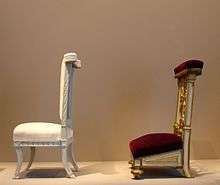
Actual chair dimensions are determined by measurements of the human body or anthropometric measurements. The two most relevant anthropometric measurement for chair design is the popliteal height and buttock popliteal length.
For someone seated, the popliteal height is the distance from the underside of the foot to the underside of the thigh at the knees. It is sometimes called the "stool height". The term "sitting height" is reserved for the height to the top of the head when seated. For American men, the median popliteal height is 16.3 inches (410 mm) and for American women it is 15.0 inches (380 mm).[27] The popliteal height, after adjusting for heels, clothing and other issues, is used to determine the height of the chair seat. Mass-produced chairs are typically 17 inches (430 mm) high.
For someone seated, the buttock popliteal length is the horizontal distance from the back most part of the buttocks to the back of the lower leg. This anthropometric measurement is used to determine the seat depth. Mass-produced chairs are typically 15–17 inches (38–43 cm) deep.
Additional anthropometric measurements may be relevant to designing a chair. Research has shown that the best seated posture is a reclined posture of 100°–110°.[28] Hip breadth is used for chair width and armrest width. Elbow rest height is used to determine the height of the armrests. The buttock-knee length is used to determine "leg room" between rows of chairs. "Seat pitch" is the distance between rows of seats. In some airplanes and stadiums the leg room (the seat pitch less the thickness of the seat at thigh level) is so small that it is sometimes insufficient for the average person.
For adjustable chairs, such as an office chair, the aforementioned principles are applied in adjusting the chair to the individual occupant. Caster wheels are attached to the feet of chairs to give more mobility. Gas springs are attached to the body of the chair in order to give height adjustment and more comfort to the user.
Armrests

A chair may or may not have armrests; chairs with armrests are termed "armchairs". In French, a distinction is made between fauteuil and chaise, the terms for chairs with and without armrests, respectively. In Germany, an armchair was once called a Krankensessel, or sick-chair, because it was intended for people who were too ill to stand or sit without extra support.[29]
If present, armrests will support part of the body weight through the arms if the arms are resting on the armrests. Armrests further have the function of making entry and exit from the chair easier (but from the side it becomes more difficult). Armrests should support the forearm and not the sensitive elbow area. Hence in some chair designs, the armrest is not continuous to the chair back, but is missing in the elbow area.
Seats
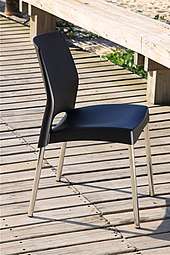
Chair seats vary widely in construction and may or may not match construction of the chair's back (backrest).
Some systems include:
- Center seats where a solid material forms the chair seat
- Solid wood, may or may not be shaped to human contours
- Wood slats, often seen on outdoor chairs
- Padded leather, generally a flat wood base covered in padding and contained in soft leather
- Stuffed fabric, similar to padded leather
- Metal seats of solid or open design
- Molded plastic
- Stone, often marble
- Open center seats where a soft material is attached to the tops of chair legs or between stretchers to form the seat
- Wicker, woven to provide a surface with give to it
- Leather, may be tooled with a design
- Fabric, simple covering without support
- Tape, wide fabric tape woven into seat, seen in lawn chairs and some old chairs
- Caning,
- Rush, wrapped from rush, heavy paper, strong grasses, or hand twisted while wrapped with cattails to form the seat, usually in a pattern of four trapezoids meeting in the center, and on rare occasions, in elaborate patterns
- Reed,
- Rawhide
- Splint, ash, oak or hickory strips are woven
- Metal, Metal mesh or wire woven to form seat
Standards and specifications
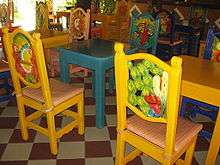
Design considerations for chairs have been codified into standards. ISO 9241, "Ergonomic requirements for office work with visual display terminals (VDTs) – Part 5: Workstation layout and postural requirements", is the most common one for modern chair design.
There are multiple specific standards for different types of chairs. Dental chairs are specified by ISO 6875. Bean bag chairs are specified by ANSI standard ASTM F1912-98.[30] ISO 7174 specifies stability of rocking and tilting chairs. ASTM F1858-98 specifies plastic lawn chairs. ASTM E1822-02b defines the combustibility of chairs when they are stacked.
The Business and Institutional Furniture Manufacturer's Association (BIFMA)[31] defines ANSI/BIFMA X5.1 (titled: General-Purpose Office Chairs – Tests) for testing of commercial-grade chairs. It specifies things like:
- chair back strength of 150 pounds (68 kg)
- chair stability if weight is transferred completely to the front or back legs
- leg strength of 75 pounds (34 kg) applied one inch (25 mm) from the bottom of the leg
- seat strength of 225 pounds (102 kg) dropped from six inches (150 mm) above the seat
- seat cycle strength of 100,000 repetitions of 125 pounds (57 kg) dropped from 2 inches (51 mm) above the seat
The specification further defines heavier "proof" loads that chairs must withstand. Under these higher loads, the chair may be damaged, but it must not fail catastrophically.
Large institutions that make bulk purchases will reference these standards within their own even more detailed criteria for purchase.[32] Governments will often issue standards for purchases by government agencies (e.g. Canada's Canadian General Standards Board CAN/CGSB 44.15M[33] on "Straight Stacking Chair, Steel" or CAN/CGSB 44.232-2002 on "Task Chairs for Office Work with Visual Display Terminal").
Chairs may be rated by the length of time that they may be used comfortably – an 8-hour chair, a 24-hour chair, and so on. Such chairs are specified for tasks which require extended periods of sitting, such as for receptionists or supervisors of a control panel.
Accessories
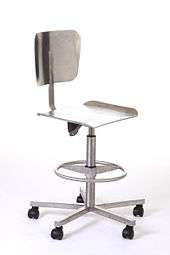
In place of a built-in footrest, some chairs come with a matching ottoman. An ottoman is a short stool that is intended to be used as a footrest but can sometimes be used as a stool. If matched to a glider chair, the ottoman may be mounted on swing arms so that the ottoman rocks back and forth with the main glider.
A chair cover is a temporary fabric cover for a side chair. They are typically rented for formal events such as wedding receptions to increase the attractiveness of the chairs and decor. The chair covers may come with decorative chair ties, a ribbon to be tied as a bow behind the chair. Covers for sofas and couches are also available for homes with small children and pets. In the second half of the 20th century, some people used custom clear plastic covers for expensive sofas and chairs to protect them.
Chair pads are cushions for chairs. They contain cotton or foam for padding. Some are decorative. In cars, they may be used to increase the height of the driver. Orthopedic backrests provide support for the back. Car seats sometimes have built-in and adjustable lumbar supports. These can also be used on kitchen chairs.
Chair mats are mats meant to cover different types of flooring. They are usually made from plastic. This allows chairs on wheels to roll easily over the carpet and protects the carpet or floor. They come in various shapes, some specifically sized to fit partially under a desk.
Remote control bags can be draped over the arm of easy chairs or sofas and used to hold remote controls for home cinemas. They are counter-weighted so as to not slide off the arms under the weight of the remote controls.
Chair glides are attached to the feet of chairs to prevent them from scratching or snagging on the floor.
An antimacassar is a cloth covering for a headrest to protect the fabric and enable easy washing.
As sculptural and art forms
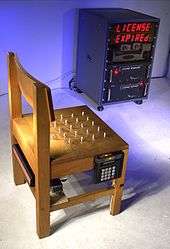
The Broken Chair is a monumental sculpture in wood, constructed of 5.5 tons of wood, 12 metres (39 ft) high standing across the street from the Palace of Nations in Geneva. It has broken leg symbolizing opposition to land mines and cluster bombs. In 2001, Steve Mann exhibited a chair sculpture at San Francisco Art Institute. The chair had spikes that retracted when a credit card was inserted to download a seating license. Later other museums and galleries were equipped with the "Pay to Sit" chair, with a global central seating license server located in Toronto. The first sitting session was free, with a database of persons who had already used their free session.
In a performance piece at the 2012 Republican Political Convention, Clint Eastwood addressed an empty chair, as if it represented President Barack Obama (meant to be construed as MIA or ineffectual). The address was controversial, whether it was poignant or bizarre.[34] Japanese designer Tokujin Yoshioka has created several chairs as art forms such as "Honey-pop": honey-comb paper chair (2001), "Pane chair": natural fiber chair (2006), "Venus": natural crystal chair (2007).
In language
- If someone "nearly fell off their chair" after being informed about something, it was because they were very shocked or surprised.[35]
- An orchestra awards the best player in a particular section a "chair" or "principal seat" based on ability. The first chair of the section plays the solos, and in string sections, determines the bowings. In professional orchestras, the first chair player receives higher pay. It is also common for this position to be known as "first stand", a reference to the portable lectern on which the musicians put their sheet music. However, the person who is first chair in the first violin section is usually referred to as the concertmaster in the US or leader in the UK.
- In academia, an endowed chair is a prestigious appointment for a professor, paid for by a dedicated funding source.
- A chair is the highest officer of an organized group, such as the chair of the board, the head of the Board of Directors in a company or non-profit organization.
- "Musical chairs" is a common party game, and a colloquial expression to describe people shuffling from seat to seat, around different locations, or from one job title to another.
- In American slang, to say someone will "get the chair" is to say that they will be executed by an electric chair.[36] Alternatively, it can be a metaphor for other harsh punishment.[36]
See also
- List of chairs for an extended list types, such as the lift chair, papasan chair, swivel chair.
- Chair pose
- Chair squat
- Riding-like sitting
- Seating assignment
- Splat (furniture), the central vertical element of a wooden chair back
References
- "Chair". The Free Dictionary By Farlex. Retrieved 13 May 2012.
- "Chair". Dictionary.com. Retrieved 13 May 2012.
- "Armchair". The Free Dictionary By Farlex. Retrieved 13 May 2012.
- "Recliner". Dictionary.com. Retrieved 13 May 2012.
- "Wheelchair". Dictionary.com. Retrieved 13 May 2012.
- "Online Etymology Dictionary". Retrieved 14 February 2017.
- "Architecture of the Palace". www.parliament.uk. Retrieved 13 May 2012.
- "Speaker's Chairs". The House of Commons. Retrieved 13 May 2012.
- "Professor". The Free Dictionary By Farlex. Retrieved 13 May 2012.
- "What is an "Endowed Chair?"". The University of Utah. Archived from the original on 31 May 2012. Retrieved 13 May 2012.
- Cregan-Reid, Vybarr (26 October 2018). "Anthropocene: why the chair should be the symbol for our sedentary age". The Conversation. Retrieved 9 November 2018.
- "Furniture". Ancient Egyptian Furniture. Archived from the original on 21 October 2008. Retrieved 13 May 2012.
- "Furniture". Ancient Egyptian Furniture. Archived from the original on 21 October 2008. Retrieved 13 May 2012.
- "Is This the World's Most Famous Chair?". TreeHugger. Retrieved 2017-06-11.
- Kieschnick, John. The Impact of Buddhism on Chinese Material Culture, Princeton University Press, 2003, pp. 222–248.
- "From Benches to Barstools: A History of Chairs, Posture, and Society". Random History. Retrieved 13 May 2012.
- "From Benches to Barstools: A History of Chairs, Posture, and Society". Random History. Retrieved 13 May 2012.
- "What is an ergonomic chair?". Canadian Centre for Occupational Health and Safety. Retrieved 13 May 2012.
- Glenday, Craig (September 2015). Guinness World Records 2016. p. 149. ISBN 978-1-910561-01-0.
- "Definitions for Massage Actions for Massage Chairs". About.com Furniture. Archived from the original on 23 June 2012. Retrieved 13 May 2012.
- "26 Chairs Made from Recycled Materials". Home-Designing. March 2009. Retrieved 13 May 2012.
- "Hanging chair made out of Volcanic Rock". BornRich: Home of Luxur. Archived from the original on 25 April 2012. Retrieved 13 May 2012.
- "Hanging chair made out of Volcanic Rock – Bornrich". 21 March 2012. Archived from the original on 9 July 2015. Retrieved 21 July 2017.
- LaBarre, Suzanne (19 April 2011). "A Chair Made From Lollipop Sugar, Customized With Your Licks". Co.DESIGN. Retrieved 21 July 2017.
- "What is an ergonomic chair?". Canadian Centre for Occupational Health and Safety. Retrieved 13 May 2012.
- Alan Hedge, ed. (2017). "15.5.1.4". Ergonomic Workplace Design for Health, Wellness and Productivity. CRC Press. ISBN 978-1-4665-9843-0.
- "Basic Body Measurements". cdc.gov. Archived from the original on 30 March 2009.
- Hedge, chapter 1.3.3
- "International Vanities". The Living Age. Fifth series. V. Boston: Little and Gay. 1874. p. 105.
- "Shinobu Matsumura". 7 February 2007. Archived from the original on 7 February 2007. Retrieved 21 July 2017.
- "BIFMA". bifma.org.
- "06-12a.html". state.tx.us. Archived from the original on 8 September 2006. Retrieved 21 July 2017.
- "CGSB 44.15M". TechStreet.com.
- Tina Daunt. "Invisible Obama: The Backlash for Mitt Romney and Clint Eastwood". The Hollywood Reporter. Retrieved 7 January 2016.
- "Nearly/Almost Fall off your Chair". Cambridge Dictionary. Retrieved 22 August 2016.
- "Chair". Dictionary.com. Retrieved 22 August 2016.
Further reading
| Wikimedia Commons has media related to Chairs. |

- . Encyclopædia Britannica. 5 (11th ed.). 1911.
- de Dampierre, F. (2006). Chairs: A History. Harry N. Abrams. ISBN 0-8109-5484-2
- Fiell, C. (2005). 1000 Chairs. (25th ed.). Taschen. ISBN 3-8228-4103-X
- Miller, J. (2009). Chairs. Conran. ISBN 1-84091-523-4
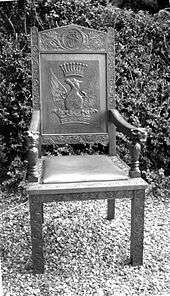
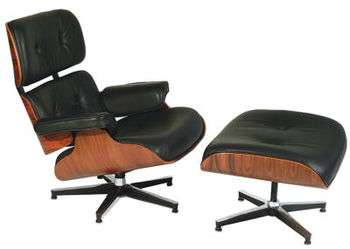
_2.jpg)